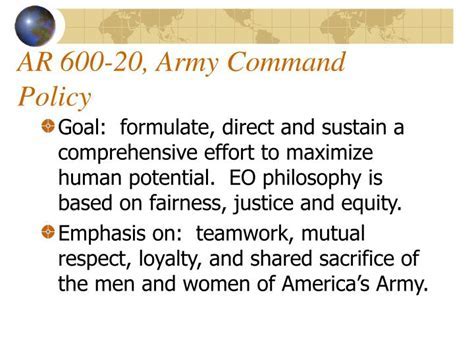5 Key Points in AR 600-20 Army Command Policy

The Army Command Policy, codified in AR 600-20, serves as the cornerstone for leadership, discipline, and operational effectiveness within the U.S. Army. This regulation outlines the responsibilities, authorities, and procedures for commanders at all levels, ensuring unity of command and mission accomplishment. Below are five key points distilled from AR 600-20, each critical to understanding its purpose and application:
1. Command Authority and Responsibility
At the heart of AR 600-20 is the principle of command authority. Commanders are vested with the legal and moral responsibility to accomplish their missions while caring for their soldiers. This authority is not delegated lightly; it requires sound judgment, ethical leadership, and a deep understanding of the unit’s capabilities. Commanders are accountable for everything their unit does or fails to do, emphasizing the importance of proactive leadership and decision-making.
2. Unity of Command
AR 600-20 reinforces the principle of unity of command, ensuring that each subordinate unit or soldier answers to one commander. This prevents confusion, duplication of efforts, and conflicting orders. Unity of command is essential for maintaining operational coherence and fostering a clear chain of responsibility. Exceptions to this principle, such as in joint or multinational operations, are carefully managed to preserve effectiveness.
3. Welfare of Soldiers
A commander’s responsibility extends beyond mission accomplishment to the welfare of soldiers. AR 600-20 mandates that commanders prioritize the physical, mental, and moral well-being of their troops. This includes providing adequate training, resources, and support systems, as well as addressing issues like sexual harassment, suicide prevention, and family readiness. A commander’s success is measured not only by mission outcomes but also by the resilience and readiness of their soldiers.
4. Disciplinary Authority and Due Process
Commanders have the authority to maintain discipline within their units, but this power is not absolute. AR 600-20 outlines procedures for imposing non-judicial punishment (Article 15) and ensures that soldiers receive due process. Commanders must act fairly, consistently, and within legal boundaries. Misuse of disciplinary authority can erode trust and undermine unit effectiveness, highlighting the need for ethical leadership and adherence to regulations.
5. Transition of Command
The transition of command is a critical process addressed in AR 600-20. It ensures continuity of operations and leadership during changes in command. Outgoing commanders are required to provide thorough briefings, hand over essential documents, and ensure the incoming commander is fully prepared to assume responsibility. A successful transition minimizes disruptions and maintains unit readiness.
FAQ Section
What is the primary purpose of AR 600-20?
+AR 600-20 establishes policies and procedures for Army command, ensuring effective leadership, discipline, and mission accomplishment while prioritizing soldier welfare.
Can a commander delegate their authority?
+Yes, commanders can delegate authority but not responsibility. They remain accountable for the actions of their subordinates.
What is the role of unity of command in Army operations?
+Unity of command ensures each subordinate answers to one commander, preventing confusion and promoting operational efficiency.
How does AR 600-20 address soldier welfare?
+The regulation requires commanders to prioritize physical, mental, and moral well-being, providing resources and support systems for soldiers and their families.
What happens during a command transition?
+Outgoing commanders brief incoming commanders, hand over essential documents, and ensure continuity of operations to maintain unit readiness.
AR 600-20 is more than a set of rules; it is a framework for ethical, effective, and mission-focused leadership. By understanding and applying these key points, commanders can build cohesive, disciplined, and resilient units capable of meeting the Army’s demanding standards.